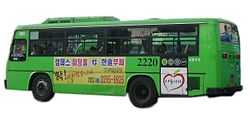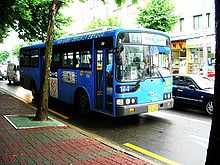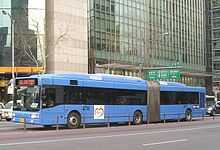Seoul Buses
Seoul Buses are public transit buses operated by the Seoul Metropolitan Government.
Bus type

There are four types of buses:[1]
- Trunk Bus (Blue) : This type of buses will operate at higher speeds and access the median bus lane connecting suburban areas to downtown Seoul. The city government is partly in charge of its operation. The city has taken full consideration to introduce 3 kinds of buses belonging to the Blue Bus category: articulated bus, CNG (compressed natural gas) bus with a low floor, and regular large-sized CNG bus. The blue color represents Seoul's skyline and Hangang (River) to symbolize security and freedom.
- Branch Bus (Green) : Green buses will be flexibly operated by private bus companies, to connect major subway stations or bus terminals outside downtown Seoul. It is similar with the city bus and the community shuttle bus currently in operation. Green stands for the mountains surrounding the city.
- Rapid Bus (Red) : The red buses will be express buses designed specially for those commuting between downtown Seoul and the metropolitan area. The color red exudes energy of speed.
- Circulation Bus (Yellow) : This bus will circle downtown Seoul and stop at stations for blue buses and major railway stations, as well as business, tourist and shopping areas. Yellow was selected for its dynamic and friendly image.
Route numbers specify area divisions. For Trunk and Branch Bus, the first digit indicates the area where the route begins, and the second digit indicates where the route ends. For Rapid Bus, the first digit is always 9, and the second indicates the area in which the route begins. The first digit of Circulation Bus indicates the area in which the bus circles. Route number which start with 8 indicates holiday/rush-hour only branch buses. For all lines, any remaining numbers are individual routes.
Numbering system
With the improvement of its public transportation system, Seoul introduced a new bus numbering system, including area numbers in order to facilitate recognition of route outlines.[2]
- Area 0 : Jongno-gu, Jung-gu, Yongsan-gu
- Area 1 : Dobong-gu, Gangbuk-gu, Seongbuk-gu, Nowon-gu. (also Uijeongbu, Yangju)
- Area 2 : Dongdaemun-gu, Jungnang-gu, Seongdong-gu, Gwangjin-gu. (also Guri, Namyangju)
- Area 3 : Gangdong-gu, Songpa-gu. (also Hanam, Gwangju (Gyeonggi Province))
- Area 4 : Seocho-gu, Gangnam-gu. (also Seongnam, Yongin)
- Area 5 : Dongjak-gu, Gwanak-gu, Geumcheon-gu. (also Anyang, Gwacheon, Uiwang, Ansan, Gunpo, Suwon)
- Area 6 : Gangseo-gu, Yangcheon-gu, Yeongdeungpo-gu, Guro-gu. (also Incheon, Bucheon, Gwangmyeong, Gimpo, Siheung)
- Area 7 : Eunpyeong-gu, Mapo-gu, Seodaemun-gu. (also Goyang, Paju)
Vehicles


Most buses in South Korea are domestic models and are made either by Daewoo or Hyundai. Buses use either compressed natural gas, electric batteries or a combination of both. In the past, diesel buses also ran until being retired.
Current buses:
- Daewoo Bus BH116 and FX116 (CNG) - For Rapid buses.
- Daewoo Bus BS090 (CNG) - For Branch & Circulation buses; some retired
- Daewoo Bus BS106 (CNG) - For Trunk & Branch buses; some retired
- Daewoo Bus BS110CN/120CN Non-step low rider (CNG) - For Trunk, Branch buses.
- Hyundai Super Aero City (CNG) - with 21, 38 or 45 seats. For Rapid, Trunk & Branch buses; some retired
- Hyundai New Super Aero City (CNG) - For all buses.
- Hyundai New Super Aero City Non-step Low Rider (CNG) - For Trunk, Branch & Circulation buses.
- Hyundai Global 900 (CNG) - For Branch buses.
- Hyundai Aero Space LS (CNG) - For Trunk & Rapid buses.
- Hyundai Universe Space Elegance (CNG) - For Rapid buses.
- Iveco CityClass (18m) - For Trunk buses.
Retired buses:
- Daewoo Bus BH115H and BH116 (Diesel)
- Daewoo Bus BS090 (Diesel)
- Daewoo Bus BS106 (Diesel)
- Daewoo Bus BS106L (Diesel)
- Hyundai Aero City 540L/SL (Diesel)
- Hyundai Super Aero City (Diesel)
- Kia Motors/Asia Motors Cosmos, New Cosmos (Diesel)
See also
- Seoul
- Seoul Subway
- T-money : Transportation Card System
- Upass (South Korea) : Transportation Card System
- Transportation in Bundang
References
- ↑ "Getting About:Bus". Infinitely yours, Seoul. Seoul Metropolitan Government. Retrieved 6 October 2012.
- ↑ "Seoul Transportation". Life in Korea. Retrieved 6 October 2012.
External links
| |||||||||||||||||||||||||||||||
